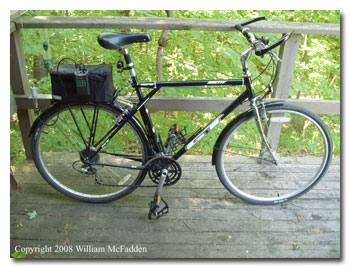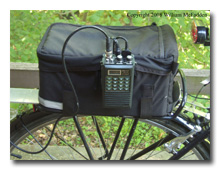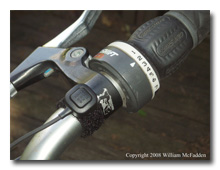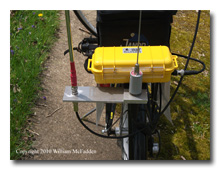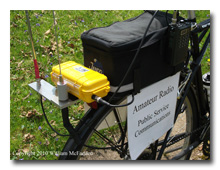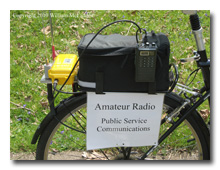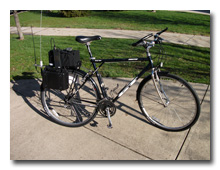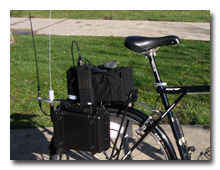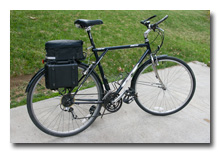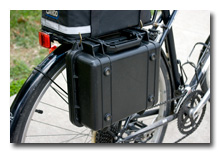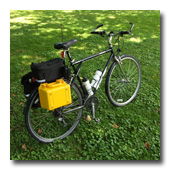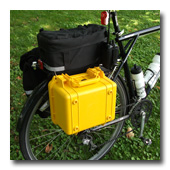by William Eric McFadden, WD8RIF
Note: This page is out-of-date and is maintained only for archival purposes. For current information and photos about my bicycle-mobile station, visit the new Bicycle-Mobile page.
Note: The ICOM IC-02AT HT referenced below is no longer functional. Until I determine how to best mount my Yaesu FT-60R on the bicycle, I will use use a 2-watt ICOM IC-2AT HT on the bicycle. Initial tests indicate 2-watts into a 1/2λ antenna is sufficient to cover the entire marathon course. (March, 2012)
I am an avid bicyclist and enjoy combining amateur radio with my cycling. I have built a VHF/UHF FM bicycle-mobile station and I carry my QRP HF station to field events on my bicycle.
I built my bicycle-mobile station in the winter of 2004 in order to be able to ride bicycle-mobile helping the Athens County Amateur Radio Association (ACARA) provide communications support to the 2004 running of the Athens (Ohio) Marathon (link). For the 2004 event, the 2m HT and antenna system were completely successful; I could successfully hit the repeater over the entire 26.2 mile course except for one small space near the far-end of the course.
I have ridden bicycle-mobile in support of the Athens Marathon every year since 2004. Starting with the 2005 running of the Athens Marathon, I also carried an APRS station on the bicycle.
In addition to the Athens Marathon, I've used my bicycle-mobile station in support of the Athens MS-Walk, Run Like Hell 5K Run for Cystic Fibrosis, and Pelotonia.
-
The bicycle is a late-nineties GT Arette steel-frame 21-speed hybrid. To this bicycle I have added full fenders, a rear rack and bag, a Sigma Sport BC-400 computer, a Terry saddle, a Princeton EOS (1-watt Luxeon LED) or Nite Hawk Emitter (1.2-watt Luxeon LED) headlight, a Planet Bike Superflash ½-watt LED taillight, two water bottle cages, handlebar extensions, Shimano SPD clipless pedals, a tire pump, and handlebar-mounted push-to-talk (PTT) button. The front wheel and fork have been replaced, the originals having been trashed in an accident. (As might be evident, the above photo is old.)
-
The radio is an ancient ICOM IC-02AT. This big HT hangs on right side of the rear luggage bag. (If heavy rain threatens, I can put the HT inside the bag, and I have made a plastic "raincoat" to keep the bag dry.) For power I use the HT battery pack mounted on the transceiver or I stash a gel-cell or RC NiCd battery in the bag. I investigated mounting the HT on the handlebar but the size of this venerable transceiver makes this just about impossible. I have found that the current location of the radio on the rear bag works well enough; I can change power level and adjust the volume and squelch from the seat while under way. I shouldn't need to change frequency while riding.
I have added a handlebar-mounted PTT to the bicycle. I bought several of these velcro-mount PTT buttons at the 2008 Dayton Hamvention for one dollar each from a supplier of motorcycle communications systems.
I can also use an IC-2AT HT on the bicycle, mounting it as described above.
I have given some thought to getting a smaller HT for use on the bike. If I actually end up with a modern, small HT, I'll look again at handlebar-mounting the rig.
-
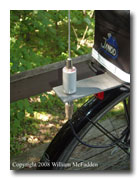 The antenna for the single-radio set-up is a 1/2λ whip mounted on an aluminum sheet
sandwiched between the rear rack and bag and secured with velcro. Initially, the antenna
was an MFJ 1/2λ extendable BNC-mount whip. While this antenna was inexpensive and
highly effective, it was also relatively fragile. I have replaced the extendable whip
with a Larsen SO239-mount 1/2λ antenna which has proven to be just as effective but
is much more rugged. (For details on the antennas for the two-radio set-up, see
APRS, below.)
The antenna for the single-radio set-up is a 1/2λ whip mounted on an aluminum sheet
sandwiched between the rear rack and bag and secured with velcro. Initially, the antenna
was an MFJ 1/2λ extendable BNC-mount whip. While this antenna was inexpensive and
highly effective, it was also relatively fragile. I have replaced the extendable whip
with a Larsen SO239-mount 1/2λ antenna which has proven to be just as effective but
is much more rugged. (For details on the antennas for the two-radio set-up, see
APRS, below.)
For short radio-equipped rides, or when I don't want to mount the 1/2λ antenna bracket, I mount a whippy 1/4λ directly on the HT.
-
Finding a suitable headset gave me a great deal of difficulty. I tried several headsets before finding one which works well on the bicycle and fits me when I'm wearing my helmet.
Initially, I tried an MFJ-293i earbud boom headset, which was was comfortable and didn't interfere with the operation of the bicycle, but the microphone audio was uselessly low.
Next, I bought a Radio Shack ICOM-compatible single-ear boom-mike with VOX when they were clearance-priced at $9.95, but I couldn't come up with a good way to mount this to my helmet and found that the gap between my ear and the speaker allowed a great of wind noise on receive.
More recently, after reading good reviews, I purchased a Pryme SPM-400A earbud mini-boom headset and a third-party remote PTT. Unfortunately, like the MFJ unit, this headset also provided transmit audio that was much too low; in addition, it suffered from a great deal of wind-noise while I was in motion even after I added a foam windscreen. On the other hand, this headset featured a socket for a remote PTT button, a feature that worked very well.
Finally, I found the solution already in my 'shack in the form of a single-ear boom headset I had built back in the '80s. Somewhat surprisingly, this headset, built around a Labtec computer headset and featuring a replacement microphone element of the correct impedence, fits well underneath my helmet. To use this headset with the handlebar-mount PTT button, I added a 3/32" socket to the home-brew PTT/interface-box. On-the-road tests have demonstrated that the headset is comfortable under the helmet and works well—receive audio is excellent, transmit audio is good, wind-noise is minimal even at speed, and the handlebar-mounted PTT works very well.
Prior to finding a suitable headset, I used an ICOM speaker-mic attached to a lanyard around my neck, the lanyard preventing any possibility of the speaker-mic falling and tangling in the spokes. Even after finding a suitable headset, I still use a speaker-mic and lanyard when I don't want to wear the headset. This solution isn't ideal for long rag-chews, but it works well enough for occasional, short transmissions.
-
For the 2005 Athens Marathon, I added Automatic Packet Reporting System (APRS) capability to the bicycle-mobile station in order to provide real-time graphical indication of the location of the race-leader and last runner to net control, the event organizers, and the viewing public. W8KVK, KB9AFT, and KC8OVB developed the APRS receive-side portion of this project, including a custom marathon-route map and a very clever smart-phone interface to allow the race organizers and the public view the position of the lead and last runners. (In the "APRS References / Links of Interest", below, find a link to the presentation to the 2011 TAPR and ARRL Digital Communications Conference by W8KVK and KB9AFT on this project.)
APRS Configuration 1: 2005-2009
-
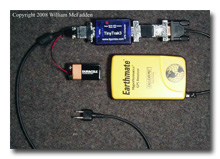 For the 2005 running of the Marathon, I purchased a used serial-version Delorme
Earthmate GPS receiver (photo), a Byonics
TinyTrak3 GPS Encoder (photo), and a Byonics GST-1
GPS Sentence Translator (photo). Because we planned to
use the same frequency for APRS and the voice net, I built an interface box
(photo) to connect all these items, the IC-02AT
transceiver, and a speaker-mic together. For occasions when I don't need the
speaker-mic, I built a simpler interface APRS-only (photo).
All of these items fit within my bicycle's rear luggage bag.
For the 2005 running of the Marathon, I purchased a used serial-version Delorme
Earthmate GPS receiver (photo), a Byonics
TinyTrak3 GPS Encoder (photo), and a Byonics GST-1
GPS Sentence Translator (photo). Because we planned to
use the same frequency for APRS and the voice net, I built an interface box
(photo) to connect all these items, the IC-02AT
transceiver, and a speaker-mic together. For occasions when I don't need the
speaker-mic, I built a simpler interface APRS-only (photo).
All of these items fit within my bicycle's rear luggage bag.
I used the same configuration for the 2006, 2007, 2008, and 2009 runnings of the Athens Marathon. During the 2007 running of the event, there was very heavy rain. The HT remained inside the rear luggage bag which was protected by a custom-made plastic "raincoat". I got soaked and my speaker-mic failed due to moisture, but the transceiver and APRS gear stayed dry.
The Earthmate/TinyTrak3/GST-1 system works very well. However, the old Earthmate takes considerable time to initially acquire the satellites and the whole package is somewhat bulky.
UPDATE: I have constructed the stand-alone APRS Tracker in a Pelican Case with these components; the DeLorme Earthmate GPS receiver, Byonics GST-1 sentence translator, the TinyTrak3, an ICOM IC-2AT, a 9.6v 1000mAh R/C nicad battery pack for the HT, and a 9v battery for the TinyTrak3 all fit nicely within a Pelican #1200 case that has been fitted with a gasketed BNC feed-through for connection to an antenna. The APRS Tracker in a Pelican Case can be carried on my bicycle using the same easily-mountable, easily-removable rear-rack-fixture I use to safely transport my KX3 Travel Kit on the bicycle.
APRS Configuration 2: 2010-2013
-
For the 2010 running of the Athens Marathon, the ACARA decided to move the APRS net off the voice-net frequency. To most easily accomplish this, the ACARA purchased a Byonics Micro-Trak AIO tracker. The Micro-Trak AIO is a complete, self-contained tracker consisting of a sensitive GPS receiver, a TinyTrak3 interface, and an 8-watt 2m transmitter mounted inside a small weather-proof Pelican case. Having the APRS on a different frequency than the voice-net allows a much higher packet transmission-rate of one every 35-seconds and reduces the number of packets lost due to collisions with traffic on the voice-net.
To enable the mounting of a second 2m antenna to the bicycle, I added a side-arm to the original antenna bracket. The original SO-239 feedthrough holds the two pieces of aluminum together. A BNC feedthrough serves as the mount for the second antenna, an MFJ 1/2λ extendable BNC-mount whip. During the 2010 Marathon, I used the MFJ 1/2λ extendable whip for the voice radio and the Larsen 1/2λ antenna for the Micro-Trak AIO. I found that the mass in the side-arm and second antenna was enough to nearly defeat the original velcro mount so I ran a screw through the original aluminum plate and the top of my luggage rack.
The Micro-Trak AIO is secured horizontally to the antenna bracket with velcro.
For the 2011, 2012, and 2013 runnings of the marathon I used the same configuration except the antenna bracket was pivoted 90° at the SO-239 feedthrough so both antennas are in the plane of the bicycle. This was done to prevent the antennas from striking each other as I ride.
The ACARA bought a second Micro-Trak AIO for the 2011 marathon so the bicyclist riding with the last runner could be easily equipped with APRS. This unit was carried vertically in a backpack and worked very well with the stock 1/4λ whip. (I discovered when I first received this second AIO that it doesn't generate computer-hash noise into my voice-net HT as both my original Earthmate/GST-1/TinyTrak3 station and the first Micro-Trak AIO do. A technician at Byonics confirms that the older AIO shouldn't be any noiser than the new AIO; Byonics repaired the older AIO free-of-charge—thank you, Byonics!)
APRS Configuration 3: 2014
-
For the 2014 running of the marathon, the ACARA deployed three bicycle-mobile APRS trackers: one with the full-marathon male lead, one with the full-marathon female lead, and one with the last runner. My set-up as I rode with the full-marathon male lead consisted of an IC-2AT HT for the voice net, the Earthmate/GST-1/TinyTrak3/IC-2AT APRS Tracker in a Pelican Case described above, and two 1/2λ antennas. In this configuration, the APRS tracker did not generate computer-hash into the voice-net radio's receiver.
The following photos are of the bicycle-mobile station as configured for support of the 2014 MS-Walk, a 5K walk which took place the day prior to the 2014 Athens Marathon. This configuration is identical to the configuration used for the Marathon except I used a flexible 1/4λ whip for the MS-Walk voice net instead of the more vulnerable 1/2λ telescoping whip I used for the Marathon voice net.
An interesting note: The ancient Earthmate GPS receiver produced more accurate position information than did the newer Micro-Trak AIO units carried by the other two bicycle-mobile operators; both the Micro-Trak AIO units were carried in a vertical orientation.
APRS References / Links of interest:
- APRS.org
- Public Service Event APRS Web Mapping for Wireless Devices by W8KVK and KA9AFT, a presentation to the 2011 TAPR and ARRL Digital Communications Conference (PDF)
- Byonics Micro-Trak AIO
- Byonics TinyTrak3
- Byonics GST-1 GPS Sentence Translator
- Byonics TinyTrak3 GPS Position Encoder, May, 2004 QST,
by Stan Horzepa, WA1LOU (PDF)
-
-
I don't operate HF while riding the bicycle but I do use my bicycle to transport myself and my HF equipment to HF field operations.
The 2008 Flight of the Bumblebees was the first event to which I bicycled. For that event, I repackaged my QRP Station in a Bag into a backpack. The backpack was heavy, hot, and uncomfortable.
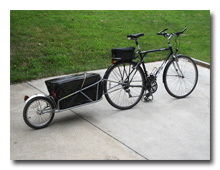 The 2010 Flight of the Bumblebees was the second event to
which I bicycled. For that event, I pulled a borrowed B-O-B "Yak" trailer behind my bicycle. The
trailer contained my K2 Travel Kit, which had been
repackaged in a weather-tight plastic box. The trailer towed easily behind the bicycle but
the weight of the trailer and station made for a very rough slog up the hills on the way
home after the event.
The 2010 Flight of the Bumblebees was the second event to
which I bicycled. For that event, I pulled a borrowed B-O-B "Yak" trailer behind my bicycle. The
trailer contained my K2 Travel Kit, which had been
repackaged in a weather-tight plastic box. The trailer towed easily behind the bicycle but
the weight of the trailer and station made for a very rough slog up the hills on the way
home after the event.
For the 2011 Flight of the Bumblebees I carried my K2 Travel Kit on the bicycle itself, repackaging the kit into a smaller soft-case and a pair of rear-mounted panniers (photos: 1 | 2 | 3). This set-up was lighter than the previous year's but the mass of the gear was high on the rear of the bike and the handling of the bicycle was very noticeably compromised.
The K2 Travel Kit is an excellent field-portable station but has proven itself to be too large and heavy for easy transport via bicycle in hilly southeast Ohio. Indeed, I haven't found myself partaking in any impromptu bicycle-transport field operations with it.
In order to encourage myself to more frequently partake in impromptu bicycle-transport HF operations I put together a KX1 Mini Travel Kit that traveled on the bicycle much more easily while retaining much of the performance of the larger station. The KX1 Mini Travel Kit was built around an Elecraft four-band KX1 and is housed in a rugged, weatherproof, Pelican #1200 case.
For the 2012 Flight of the Bumblebees I carried the KX1 Mini Travel Kit on my bicycle along with a second antenna, a clipboard, an external NiMH battery-pack, and a 2m HT (photo). The very small and lightweight station traveled very well on the bicycle. I subsequently carried the KX1 Mini Travel Kit on the bicycle several times.
In late summer 2013 I sold the KX1 to fund the purchase of an Elecraft KX3. Although it's larger and heavier than the KX1 Mini Travel Kit, the KX3 Travel Kit fits on the bicycle using the same fixture I devised to carry the KX1 Mini Travel Kit on the bicycle.
I carried the KX3 Travel Kit on the bicycle for the 2014 Flight of the Bumblebees and it traveled quite well.
